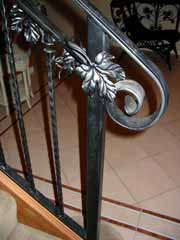Ferrous Metals used in Home Interiors
Types of Metal – Ferrous Metals
Ferrous metals contain iron or pig iron in its basic form.
These are the ones that usually rust. Pig Iron is the basis of all ferrous metals and comes from the thermal reduction (a process which uses heat and a reducing agent to separate the metal from the ore) of iron ore.
The process involves heating the iron ore in a blast furnace with coke, limestone and other materials to a temperature of 1100 degrees C which separates the hot iron from the earthy material (the ore).
Iron
Wrought Iron
Wrought Iron is produced by melting Pig Iron in a furnace with iron oxide. Wrought Iron is very strong and hard. It is easily moulded and stretched without cracking or splitting. It can be shaped in a cold or hot form. It has a better corrosion resistance than mild steel, but if left in exposed situations it will rust.
One of the world’s best examples of wrought iron work is the Eiffel Tower in Paris and early railway irons were made of wrought iron. The metal is malleable. It has little carbon content compared to other irons.

Wrought Iron Balustrade and Handrail with intricate vine and leaf detail.
Cast Iron
Cast Iron is made by melting Pig Iron with steel scrap, carbon and silicon. Numerous types of cast iron are available. Their grade of strength and hardness varies. It is a suitable product for casting and machining and is partially resistant to corrosion. It is used around the house in the form of baths and outdoor furniture. Cast iron is high in carbon, which tends to make it free running when molten and is therefore good for intricate moulds and ornate work that we may see on traditional table legs and other ornate castings.
It has been used in original iron bridges, street lamps and as mentioned above table bases. As a table base it is particularly suitable because cast iron relies on its mass for strength and is therefore very heavy, a great quality for creating a stable table. Cast iron is very heavy and also brittle, however it is also very strong and resists corrosion, hence we see it in modern use as bollards and gratings.
Remember that one of its great qualities is that it is very free running, so intricate designs can be used with cast iron. Once cooled and set it is not malleable or ductile. Cast iron is an excellent base for vitreous enamel.
To Continue Articles on Interior Design and Decorating Interior Finishes – Metals – next page is Steel
